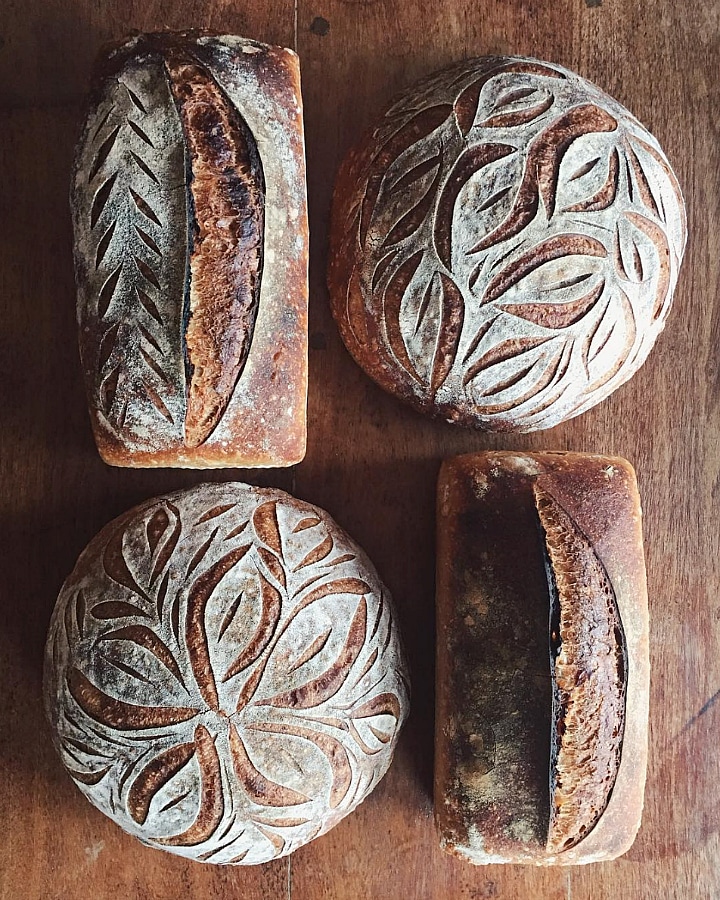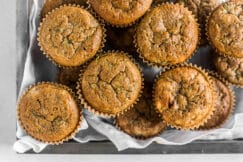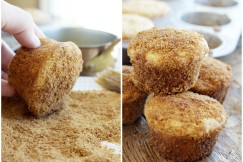I’ve wanted to share a fermented sourdough bread recipe for a very long time, so I’m thrilled to write this post for you!
As I’ve mentioned before, a grain-free diet isn’t meant to be lifelong. Once you’ve taken the proper steps to heal, you can slowly add properly prepared grains back into your diet with the help of your nutritionist or holistic practitioner.
Fermented sourdough bread can often be tolerated by those with gluten sensitivities and can be a good first bread to try after you’ve been avoiding grains for a long period of time.
The process of slow fermentation allows the bacteria to break down the carbohydrates and gluten and also neutralizes the phytic acid, making it easier for the body to digest. And, sourdough bread contains healthy resistant starch and doesn’t raise blood glucose levels as much as conventional wheat bread.
Making a sourdough starter and then a fermented bread can often seem incredibly intimidating, so I hope I can take the fear out of it for you. This week I’ve been showing the step-by-step process over on my Instagram stories, and plan to offer more future IG stories so you can become familiar with the process.
This recipe comes from my friend Min Kim. She’s a master at making gorgeous sourdough loaves – you need to check out her Instagram feed! I first learned how to make sourdough using her recipe and she was kind enough to allow me to publish her recipe here for you.
She has an ebook, True Sourdough Bread, with step-by-step photos and a bonus sourdough pizza recipe. The book is just $4.95, and you can purchase and download here. Min teaches sourdough classes in Solana Beach, CA. So, if you’re in the area, you check out the schedule at Biodynamic Wellness to find out when she’s teaching.
To make a sourdough bread, you’ll need a sourdough starter. Here is an easy homemade recipe. You can also purchase the Culture’s for Health Sourdough Starter and follow the directions written on the box.
Here’s a list of the materials you’ll need to make your sourdough:
16-ounce (or lager) mason jar
Digital scale that measures in grams and can zero out
Large glass or ceramic bowl
Dough whisk
Large wooden spoon
2 Brotform (proofing basket) you can use round or oblong
Dutch oven (at least 5 1/2 quart or larger) or Cast Iron Combo Cooker
Clean, lint-free towels
Oven mitts
Oven thermometer
Scoring tool or razor (optional)
2 large plastic bags (like the kind you can put a turkey in)
Here is a video I made over on Instagram that shows you step-by-step how to make this recipe.
All right! Here’s the recipe for fermented sourdough bread!
PrintFermented Sourdough Bread
- Prep Time: 40 minutes
- Cook Time: 35 minutes
- Total Time: 51 hours
- Yield: Makes 2 loaves
- Category: Baking
Ingredients
For the Levain:
- 25 grams bubbly sourdough starter
- 70 grams purified/spring water
- 70 grams organic all-purpose flour
Build the Dough:
- 725 + 50 grams purified/spring water
- 150 grams levain (see above)
- 200 grams organic whole wheat flour
- 800 grams organic all-purpose flour, divided
- 25 grams Celtic sea salt or Himalayan pink salt
Stretching, Folding and Bulk Fermentation:
- Organic white flour for dusting
For the Bake:
- About 60 grams rice flour for dusting bowls
Instructions
For the Levain:
- The evening before you make bread, mix together 25 grams starter, 70 grams water and 70 grams flour in a 16oz mason jar or small bowl with straight sides. Mark the level with tape or a rubber band. Cover the mixture with a clean towel and leave on the counter at room temperature. The mixture will be ready in 10-12 hours and will double or even triple in volume.
- Note: During hot months, this can take 6-8 hours depending on the temperature of your kitchen. You can use ice water to slow this process in the summer. Using water that is 130ºF will speed this process into 4-5 hours, but for best flavor, I recommend allowing for a longer ferment time.
Build the Dough:
- Pour 725 grams of water into a large glass or ceramic mixing bowl. Drop a tablespoon of levain into the bowl and see if it floats. If it floats, add the rest of the levian to the water and whisk to combine. If it doesn’t float, wait another hour and try again. Add 200 grams of whole wheat flour and 300 grams of organic all-purpose flour to the water mixture and combine with a dough whisk. Add the remaining 500 grams of all-purpose flour and mix with your hands, making sure there are no dry clumps of flour.
- Note: The temperature of your water in relation to your ambient room temperature is very important. In the wintertime, it’s helpful to use warmer water and in the hottest months, ice water would be appropriate.
- Cover and autolyse (let sit) for 30 minutes.
- Add 25 grams Celtic sea salt or Himalayan salt and 50 grams of water and mix by hand until incorporated. Cover the dough with a clean cloth and let rest for 30 minutes.
Stretching, Folding and Bulk Fermentation:
- Stretch and fold the dough four times (watch the video above and start at the 1:02 minute mark). Place a clean cloth over the dough and let it sit for 30 minutes. Then, stretch and fold the dough again, place a clean cloth over the dough and let sit for another 30 minutes. Repeat two more times for a total of four times.
- During the second fold, herbs, olives, nuts, etc. can be added. Cover the dough with a clean cloth and allow it to rest for an hour.
- Lightly dust a wooden board or a clean counter top with flour. Turn the dough out onto the floured surface. The dough will be sticky, so it helps to have wet hands. Using a bench knife or a large chef’s knife, cut the dough in half and make two rounds of dough. Cover with a clean cloth and let sit for another hour.
- Dust two brotforms with flour. If you don’t have a brotform, you can use a basket lined with a dishtowel (if doing this, make sure the dust the dishtowel with flour). Don’t skimp on the flour or your loaves will become difficult to remove when it’s time to bake them.
- Now it’s time to shape the dough into a boule. You will do a series of four folds: bottom to top, top to bottom, left to right and right to left, before flipping over and shaping into a round. Then, gather the ball and place it upside down in a brotform (seam side up). (Watch this video and start at minute 1:16).
For the Final Rise:
- Cover the dough loosely with a clean dish towel and allow to sit at room temp for another hour, then lightly tuck dish towel on top of the dough and place in refrigerator.
- After the dough has been in the fridge for 12 hours (or the next morning), place each of the bowls with dough in a large plastic bag (I use plastic bags that you can bake turkeys in) to keep the dough from drying out and absorbing flavors from your refrigerator. After placing the loaves in the large plastic bags the loaves will remain in the fridge for another 24 hours for a total of 36-40 hours.
For the Bake:
- Place a Dutch Oven with a lid in a cold oven. Preheat the oven to 500ºF with your pot inside for one hour. Pull a loaf out from the refrigerator. Lightly dust the top (which is actually the bottom) with rice flour. Flip the loaf out onto a small cutting board. You can now score the top with a razor or lame, if desired. Carefully remove the hot pot from the oven, slide the loaf into the pot, place the lid back onto the pot and place in the oven. Be very careful. The pot is very hot!
- Bake for 20 minutes. Carefully remove the lid (again, be careful because it’s very hot), reduce the temperature to 465ºF and bake for another 10-15 minutes until the bread is golden brown on top. You can also test for doneness with an instant read thermometer. If you put the thermometer in the middle of the loaf and it reads 190º-210ºF then it’s fully cooked.
- Remove the loaf of bread from the pot and allow the bread to cool for at least one hour. The bread will continue baking during this time.
- For your second loaf, you will return the pot to the hot oven and raise the temperature back up to 500º and let it heat up for 15 minutes before removing your second loaf from the refrigerator and repeating the process.
- Note: Because all ovens vary, you will definitely want to purchase an inexpensive oven thermometer and place it in the back to make sure that your oven temperature is consistent and accurate.
Nutrition
- Serving Size: 1









115 Comments